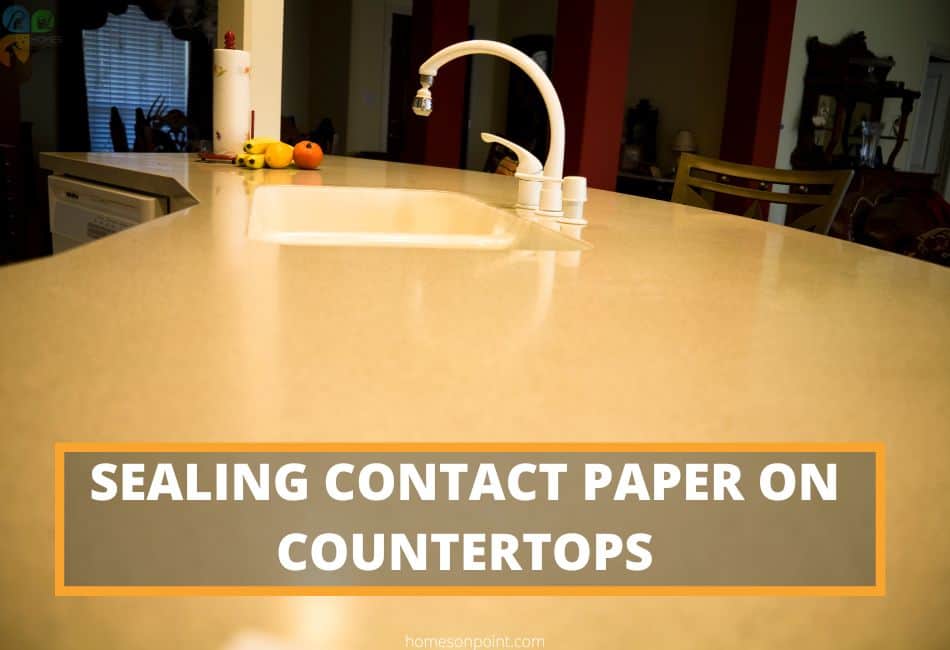The use of contact paper to cover bathroom and kitchen countertops is not a new idea. Many homeowners use this product because it is an inexpensive way to achieve the look of a more expensive countertop material, like granite or marble. Contact paper can also be used to protect surfaces from spills and scratches.
But what about sealing contact paper on countertops? Is this something that you should do?
The answer to this question is not a simple one. Sealing contact paper on countertops is not recommended by the manufacturers of contact paper. Contact paper is a durable material and already waterproof and doesn’t need to be sealed. However, you can choose to seal the cut edges to further prevent water from seeping in in cases where the contact paper may be in contact with water, like around a sink.
Contact paper comes in many types and durability levels. The thicker contact paper is, the more durable it will be.
Reasons For Sealing Contact Paper On Countertops
People feel the need to protect contact paper by sealing it for different reasons. These include
- Many people are concerned about the durability of contact paper and think that sealing it will make it last longer. There is the feeling that colored contact paper designs will wear off over time or if something should accidentally spill on it, the design will be ruined. There is also the worry of how heat resistant the contact paper is and therefore sealing it will help to protect it.
- Sealing contact paper can also give the appearance of a more finished look. It can make the seams less noticeable and give the countertop a higher-end look.
- Sealing contact paper on countertops is not necessary, but it may give you peace of mind knowing that the surface is now better protected from scratches, heat, and spills.
- Homeowners want to protect their investment and think that sealing the contact paper will make it easier to clean and keep in good condition.
- The final reason which in my opinion is more valid is to seal off the cut edges, especially around the sink area, to further prevent water from seeping in and causing damage. There is a lot of water activity that goes on around sinks in the kitchen and bathroom and sealing the edges will help to prevent any water from finding its way under the contact paper.
How To Seal Contact Paper On Countertops?
As indicated earlier, contact paper is inherently waterproof and does not need to be sealed. However, you can further protect the contact paper, by caulking the cut edges of the contact paper
Applying a seal around the cut edges of the contact paper is the most common way to further protect contact paper, especially around the sink and stove. When fixing contact paper on countertops, it is cut to size and then applied to the surface. They are usually cut larger than the surface and then tucked under the edges of cabinets. Also if there are no edge strips at the back of the counter, the contact paper is cut to flush against the wall. Again, when it gets to the stove and sink edges, the contact paper will be cut to size and applied.
This leaves a lot of exposed edges that can be sealed. When this is not done, water pools can accumulate in these areas and cause the contact paper to lift from the edges.
Use clear silicone to seal the edges. This is a clear waterproof sealant that can be applied to the exposed edges of contact paper. The reason for using clear silicon and not colored silicon is that it will not discolor the contact paper. To seal the edges of the contact paper, follow the following steps.
- Make sure the contact paper is completely dry before applying the silicon.
- Apply a small amount of silicon to the edges of the contact paper using a silicon gun. Make sure you run a smooth, straight line of silicon along the edges.
- Use your finger to smooth out the silicon along the edge. If you notice some areas don’t have enough silicone, add a little more.
- Wipe away any excess silicone with a clean cloth.
- Allow the silicone to dry before using the countertop. It takes about 30 minutes for silicone caulk to become dry to touch but takes about 24 hours to cure completely.
Alternative Way To Seal Contact Paper On Countertops
An alternative way to seal the edges of contact paper is to cover your contact paper with a layer of clear contact paper. If you are still concerned about the entire surface of your designed contact paper, overlaying it with a layer of clear contact paper will give you an extra layer of protection.
Aside from the fact that it gives an extra layer of protection, it also doesn’t hide the initial design of the paper you’ve chosen.
To do this, follow these steps:
- Wipe the surface of the contact paper to remove any dirt or debris. You wouldn’t want your contact paper to have any bubbles.
- Cut a piece of clear contact paper that is slightly larger than the designed contact paper you’ve applied to the countertop
- Remove the backing of the clear contact paper and apply it on top of the designed contact paper, starting from one end and working your way to the other. Work in small areas pealing the paper backing to avoid any bubbles. Use a hard object such as a credit card to smooth out any bubbles in the clear contact paper.
- Use a utility knife or scissors to trim off the excess clear contact paper. Make sure the seams of the two different contact papers are on each other to make them more durable and less likely to separate.
- Seal the edges with silicone caulking as described in the previous section. Squeeze clear silicone caulking along the edges of the countertop. Use your finger to smooth it out and then wipe away any excess caulking with a clean cloth.
And that’s it! You’ve now successfully protected your contact paper with an extra layer of clear contact paper.
Conclusion
Contact papers come in a variety of colors, designs, and textures which makes them ideal for adding a bit of personality to your countertops. They are durable, easy to apply, and relatively inexpensive. While it is generally not necessary to seal the entire surface of contact paper, sealing the edges is important to prevent water damage and bubbling. You can also add an extra layer of protection by covering the contact paper with a layer of clear contact paper. These two methods can help prolong the life of your contact paper and keep it looking great for an extended period. Thanks for reading.
FAQs
Q: Does contact paper on countertops last?
A: Yes, contact paper on countertops can last for years if properly cared for and maintained. Its longevity mostly depends on the quality of material and usage.
Q: How do I clean contact paper on countertops?
A: You can clean contact paper on countertops with a damp cloth or sponge. Avoid using harsh chemicals or cleaners as they may damage the material.
Q: How do you keep contact paper from peeling?
A: You can keep contact paper from peeling by sealing the edges with silicone caulking. Don’t expose the contact paper to extreme heat conditions and do not scrub with abrasive materials.
Q: Does contact paper come off easily?
A: Contact paper can come off easily if not properly sealed or applied. If the contact paper is of high quality, it might not come off easily. If the countertop has a good seal, the contact paper can be removed with minimal damage. Also with a little bit of heat, the contact paper can be removed without any adhesive residue.
Q: How do I remove air bubbles from under contact paper?
A: You can remove air bubbles from under contact paper by using a hard object such as a credit card. You can also use a needle to puncture the air bubble and then use the credit card to smooth it out.

